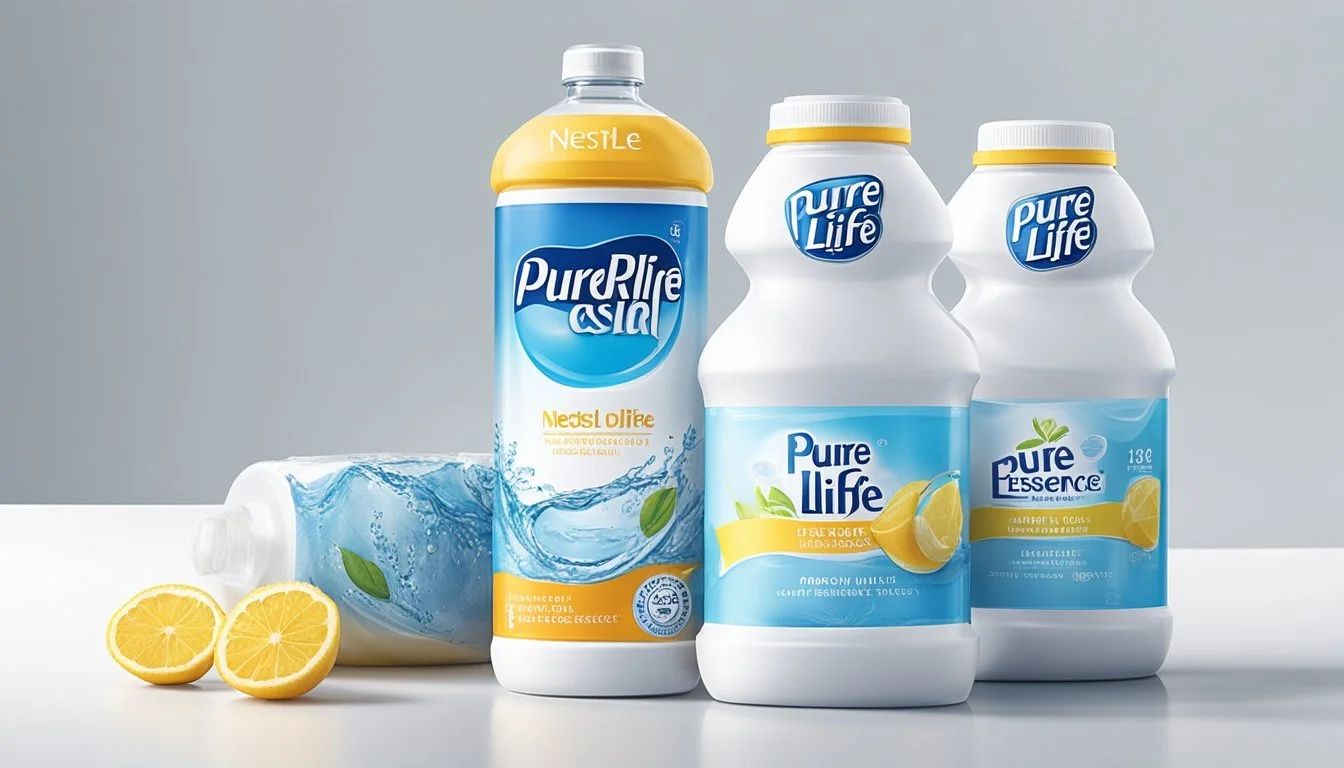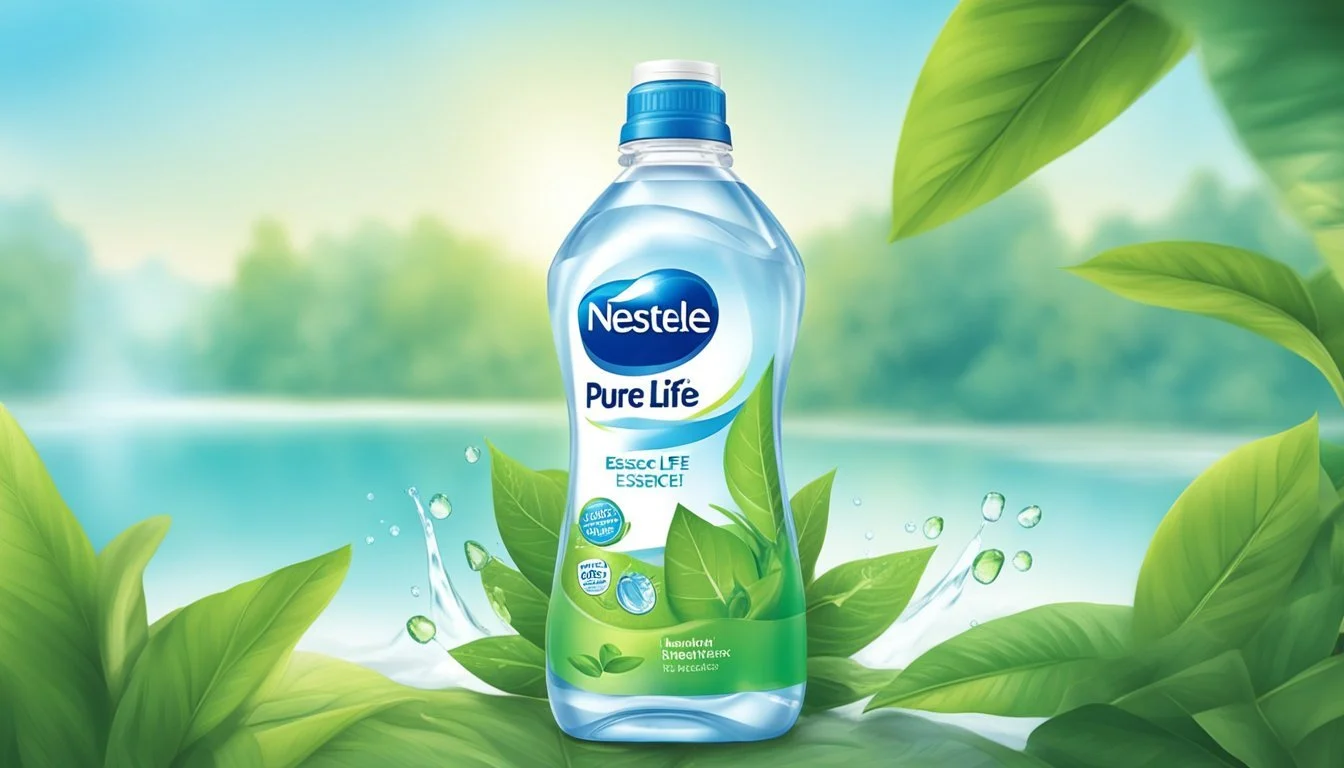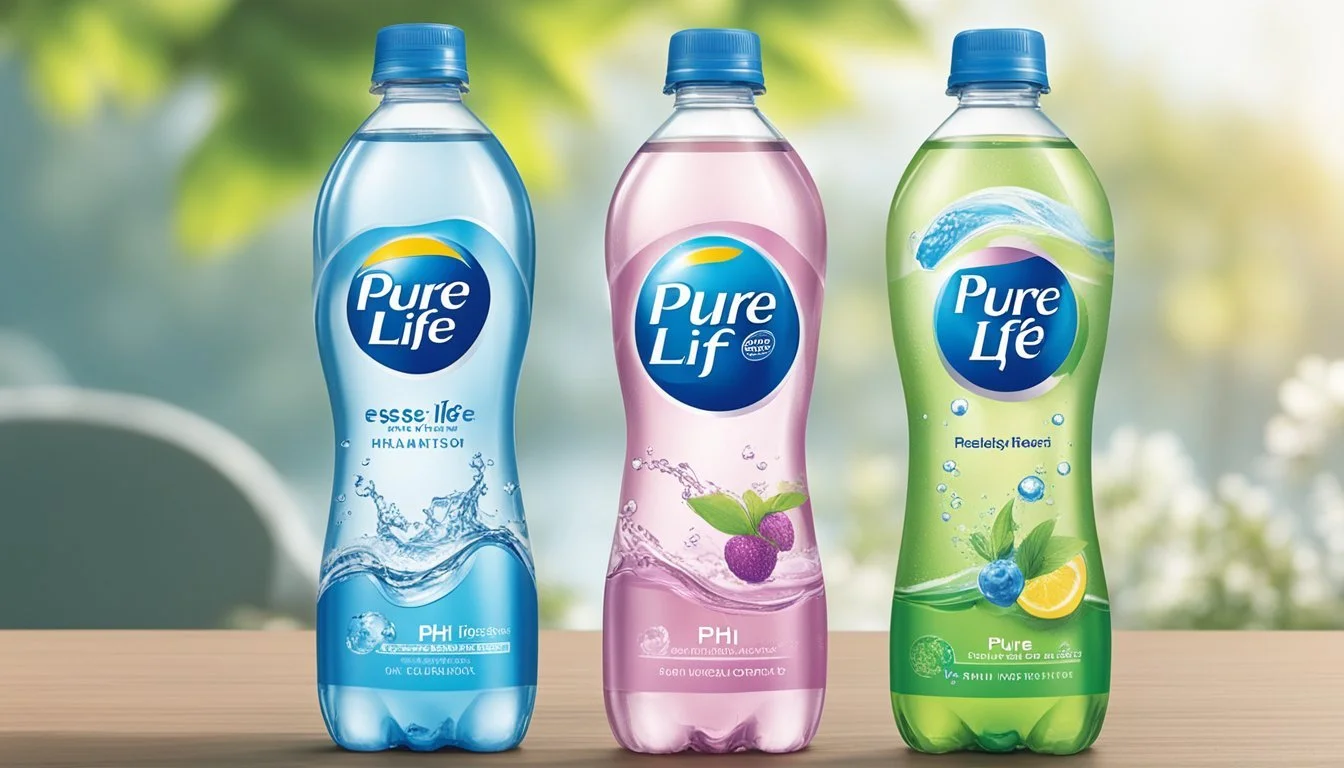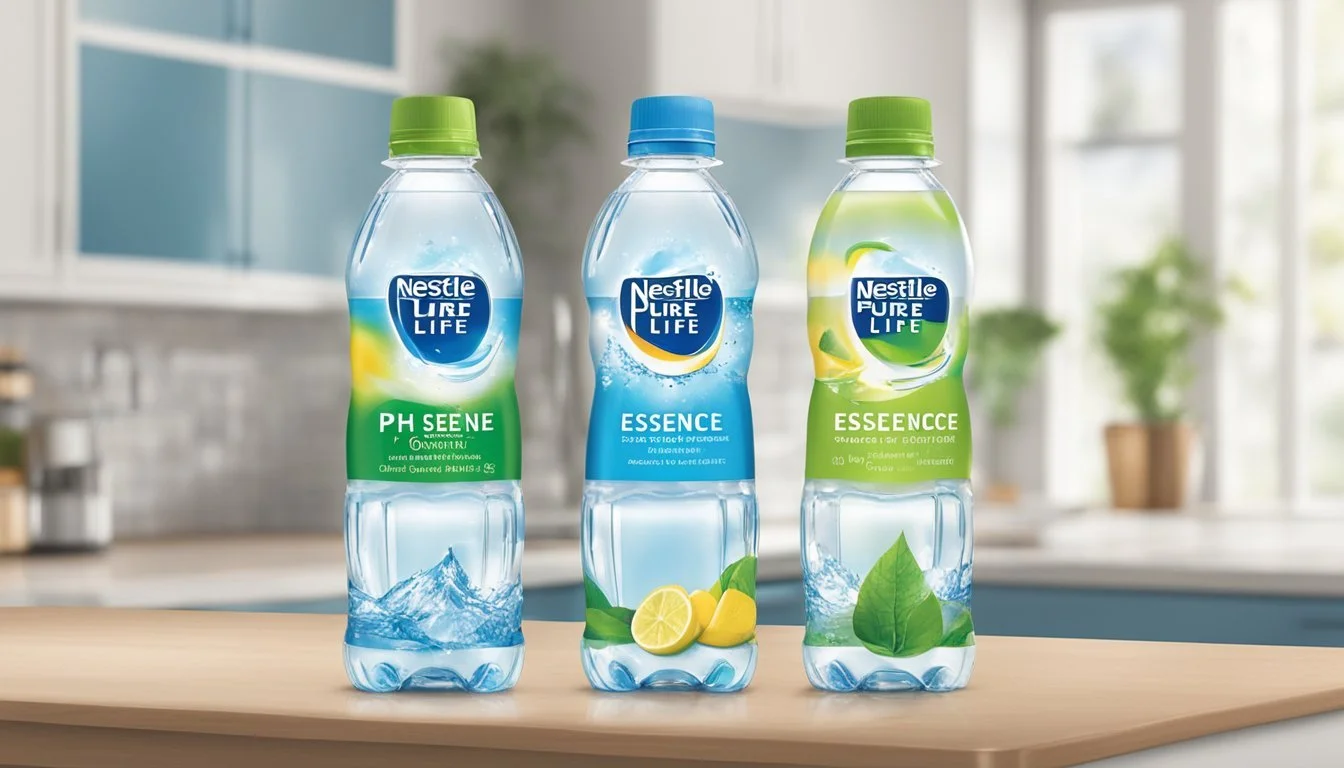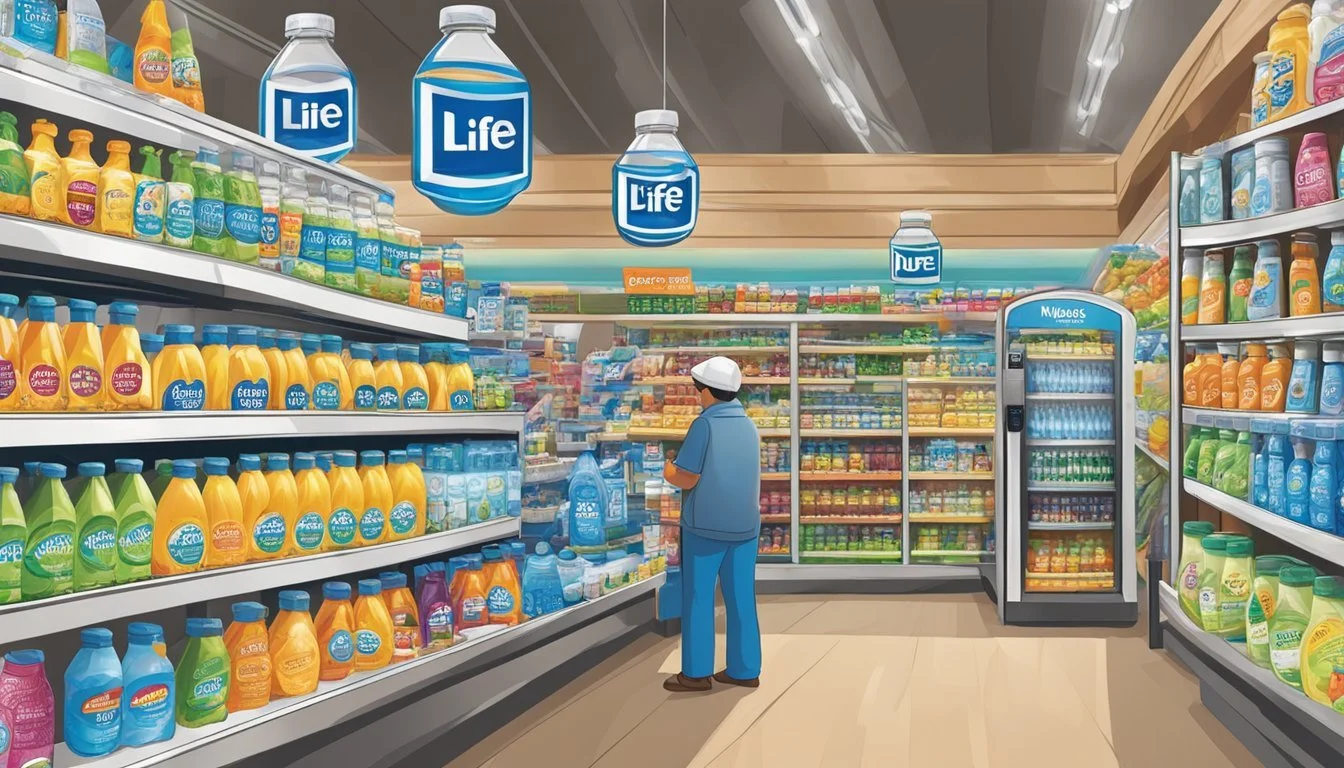Nestlé Pure Life vs. Essence pH10
Comprehensive Bottled Water Comparison
Choosing the right bottled water can significantly impact your daily hydration. When comparing Nestlé Pure Life to Essence pH10, several factors come into play including taste, source, and mineral content. Nestlé Pure Life is a popular choice known for its widespread availability and clean taste, while Essence pH10 offers the added benefit of being alkaline with a pH level of 10.
Essence pH10 stands out for its alkaline properties, which some believe offer health benefits such as improved hydration and balanced body pH levels. Nestlé Pure Life, on the other hand, remains a trusted name due to its consistency and reliability in taste and quality. For health-conscious individuals, the additional electrolytes and minerals in Essence pH10 can be appealing.
While both brands have their strengths, the ultimate choice depends on personal preference and specific health goals. Some may prefer the neutral taste and affordability of Nestlé Pure Life, whereas others might be drawn to the higher pH and potential health benefits of Essence pH10.
Understanding Bottled Water
The bottled water market has evolved significantly over the years, incorporating various types that appeal to different consumer preferences and quality measures. Key distinctions can be made between purified, spring, mineral, and alkaline waters, each with unique properties and sourcing methods.
History and Evolution of Bottled Water
Bottled water has a long history, originating in the 18th century when mineral water from natural springs was first bottled and sold for its supposed health benefits. By the 20th century, the industry expanded with technological advancements in purification and bottling processes.
The development of plastic bottles in the 1970s enabled widespread distribution and accessibility. Over time, the market diversified to include a variety of types, such as purified and alkaline water, led by both large corporations and niche brands. This evolution reflects consumer demand for convenience and perceived health benefits.
Terminology: Purified, Spring, Mineral, and Alkaline Water
Purified Water: This type undergoes extensive filtration processes, including reverse osmosis and distillation, to remove impurities and contaminants. It is sourced from any water supply and purified to meet specific quality standards.
Spring Water: Naturally sourced from underground aquifers and springs, this water must come from a natural source to be labeled as such. It maintains its mineral content, offering trace elements that can enhance flavor and provide minor health benefits.
Mineral Water: Containing a specific amount of dissolved minerals like calcium, magnesium, and potassium, mineral water comes from geologically and physically protected underground sources. It is known for its distinct taste and mineral benefits.
Alkaline Water: It has a higher pH level, usually above 7, achieved either naturally through sourcing or artificially by adding minerals. Alkaline water is often marketed for its potential health benefits, including better hydration and acid-base balance.
Current Trends in Bottled Water Consumption
The bottled water market continues to grow, driven by increased health awareness and convenience. Consumers are opting for premium and specialty waters like alkaline and mineral varieties.
Sustainability is also influencing purchasing habits, with brands emphasizing eco-friendly practices and recyclable packaging. The rise in demand for enhanced water options, such as those infused with electrolytes and vitamins, reflects ongoing shifts towards health-conscious consumption.
Health and Hydration
When comparing Nestlé Pure Life to Essence pH10, it's essential to consider various aspects related to hydration and health benefits, particularly their pH levels, electrolyte content, and overall health impacts.
The Role of pH in Hydration
The pH level of water can influence its effect on the body. Essence pH10 is noted for its higher pH level, making it an alkaline water. Alkaline water is believed by some to neutralize acid in the body, potentially aiding in reducing acid reflux and enhancing hydration.
In contrast, Nestlé Pure Life typically has a neutral pH, close to 7. Drinking water with a neutral pH is generally recommended for maintaining the body's natural balance without altering its pH levels significantly.
Understanding Electrolytes and Mineral Content
Electrolytes such as calcium, magnesium, and potassium are vital for maintaining hydration and proper bodily functions. Essence pH10 contains these essential minerals, enhancing its value for individuals needing to replenish electrolytes, particularly athletes.
Nestlé Pure Life, while providing clean and pure hydration, may have fewer electrolytes in comparison. Purified water brands like Nestlé often focus on eliminating impurities rather than augmenting it with additional minerals. For those not specifically seeking extra electrolytes, this may be sufficient.
Health Benefits and Considerations of Different Water Types
Essence pH10 may offer additional health benefits due to its high pH and mineral content, potentially aiding in digestion and overall wellness. Alkaline water proponents claim it helps in detoxification and improving energy levels, although scientific consensus varies.
Nestlé Pure Life offers reliable hydration and is well-regarded for its purity and safety. It provides the essential hydration needed for daily activities without any added flavors or minerals, making it a consistent choice for families and casual drinkers.
Both waters meet different needs based on personal preferences and specific health requirements.
Comparing Nestlé Pure Life and Essence pH10
This section will explore the key aspects of Nestlé Pure Life and Essence pH10, such as their origin, taste profiles, and their respective pH balances and alkalinity. Readers will gain insights into how these elements contribute to the quality and preference of each bottled water.
Overview of Nestlé Pure Life
Nestlé Pure Life sources its water from municipal supplies and undergoes a rigorous multi-step purification process. This process includes reverse osmosis and distillation to remove impurities. Essential minerals are added afterward to enhance flavor and nutritional benefits. Bottled at facilities across the United States, Nestlé Pure Life ensures wide availability for consumers. The brand emphasizes quality control and affordability, making it a popular choice for many households.
Overview of Essence pH10
Essence pH10 is a premium bottled water known for its high pH level of 10. This water is sourced from natural springs and undergoes minimal processing to maintain its natural mineral content. Essence pH10 focuses on providing a high-alkaline option, which some believe may offer health benefits, such as better hydration and neutralizing acidity in the body. The brand targets health-conscious consumers and those looking for a more natural, mineral-rich drinking experience.
Taste Profiles and Consumer Preferences
Nestlé Pure Life offers a clean and crisp taste due to its purification process and the addition of minerals. Many consumers find it refreshing and suitable for everyday hydration. Essence pH10, with its high pH level, has a slightly different taste profile. It is often described as smooth and slightly alkaline, appealing to those who prefer or require high-pH water. Consumer preferences can vary, with some individuals choosing Nestlé Pure Life for its neutral taste and others opting for Essence pH10 for its distinctive alkaline flavor.
pH Balance and Alkalinity Comparison
Nestlé Pure Life has a pH of around 7.3, making it neutral and suitable for general consumption. The addition of essential minerals after purification plays a role in maintaining this pH balance. Essence pH10, on the other hand, boasts a significantly higher pH level of 10. This high alkalinity is a defining feature of the brand and is marketed as having potential health benefits. The stark difference in pH levels between the two makes Essence pH10 stand out for those specifically seeking alkaline water.
Production and Sourcing
This section covers how Nestlé Pure Life and Essence pH10 source their water, the filtration processes they use, and the importance of transparency in their operations. These factors are critical for assessing which brand provides better-quality bottled water.
Water Sources and Aquifers
Nestlé Pure Life sources its water from both wells and municipal supplies, ensuring it undergoes a comprehensive purification process. The selection of these sources is based on strict quality and sustainability criteria.
Essence pH10 opts for water from natural springs and aquifers known for their mineral-rich compositions. These sources are typically located in geologically significant regions, adding unique characteristics to the water.
Sourcing plays a critical role in the taste and mineral balance of the water, impacting consumer choice significantly.
Filtration and Treatment Processes
Nestlé Pure Life uses a multi-step filtration process that includes microfiltration, reverse osmosis, and ozonation. Each step aims to eliminate impurities and bacteria, ensure consistent taste, and meet safety standards.
Essence pH10 employs advanced filtration methods while maintaining the natural alkalinity and mineral content of the water. This often includes UV treatment and carbon filtration, ensuring high purity without stripping essential minerals.
The specific filtration techniques contribute to the distinct tastes and health benefits touted by each brand.
Importance of Source Transparency
Transparency in water sourcing is vital for consumer trust. Nestlé Pure Life emphasizes its rigorous sourcing standards and consistently shares detailed information about its water sources and treatment processes.
Essence pH10 also values transparency, often providing precise details about the origin of its water and the steps taken to preserve its natural qualities. This openness helps consumers make informed choices based on clarity and trust.
Detailed disclosure about sources and processes helps both brands build credibility and allows consumers to understand what they are drinking.
Packaging and Environmental Impact
Examining the packaging and environmental impact of bottled water reveals significant differences between Nestlé Pure Life and Essence pH10. The materials used, efforts toward sustainability, and the carbon footprint are crucial factors to consider.
Materials and Recyclability of Bottles
Nestlé Pure Life bottles are primarily made from PET (polyethylene terephthalate), a type of plastic that is widely recyclable. These bottles are designed to be lightweight, reducing the plastic required per unit. Despite this, PET's effectiveness in recycling varies, with only about 50% being processed for reuse.
Essence pH10 utilizes high-quality, BPA-free plastic, which is also recyclable. They emphasize the use of eco-friendly materials to reduce environmental harm. Recycling rates and practices for these materials, however, are critical. High-quality plastic is often easier to recycle, but actual recycling depends on consumer behavior and local facilities.
Sustainability Efforts by Bottled Water Brands
Nestlé has been actively working on sustainability, focusing on water usage and recycling. They claim that less than 2.5 liters of water are required to produce one liter of bottled water. Additionally, Nestlé collaborates with other entities to improve bottle recyclability and create a circular economy.
Essence pH10 also invests in sustainability initiatives. They focus on sourcing water responsibly and minimizing waste throughout the supply chain. Their commitment includes using renewable energy in production facilities and reducing greenhouse gas emissions.
The Carbon Footprint of Bottled Water
Transporting bottled water is a major contributor to its carbon footprint. Nestlé Pure Life, being a global brand, often involves long-distance shipping, which increases emissions. However, their efforts in making lighter bottles help mitigate this impact slightly.
Essence pH10, sourced domestically and focusing on local distribution, inherently has a smaller carbon footprint. By minimizing transportation distances, they reduce emissions associated with logistics. Additionally, their use of renewable energy further lessens their overall environmental impact.
Both brands strive to minimize their environmental footprint, though their strategies and effectiveness can vary significantly.
Brand Approaches to Quality and Safety
This section examines the methods Nestlé Pure Life and Essence pH10 employ to ensure the safety and quality of their bottled water, including strategies to maintain purity, address contaminants and heavy metals, and uphold certifications and safety standards.
Ensuring the Purity of Bottled Water
Nestlé Pure Life implements a multi-stage filtration system designed to remove impurities. This process includes carbon filtration, reverse osmosis, and UV treatment to ensure the purity of their water.
Essence pH10 emphasizes its natural sourcing, drawing water from deep aquifers and passing it through a unique ionizing process to enhance its pH balance. This dual approach aims to retain beneficial minerals while ensuring any harmful substances are filtered out.
Dealing with Contaminants and Heavy Metals
Contaminant control is critical for both brands. Nestlé Pure Life conducts routine testing to detect traces of contaminants such as lead and other heavy metals. Their quality control team performs regular audits to ensure compliance with safety regulations.
Essence pH10 also focuses on contaminant removal using advanced filtration technologies. They employ activated charcoal filters and UV light purification to eliminate potential harmful substances. Their rigorous testing protocols help in maintaining the safety profile of their bottled water.
Certifications and Safety Standards
Both brands prioritize obtaining and maintaining safety certifications. Nestlé Pure Life holds several certifications, including those from NSF International and the International Bottled Water Association (IBWA). These certifications require adherence to strict quality and safety standards.
Essence pH10 also boasts certifications that highlight its commitment to safety and quality. They meet standards set by relevant health authorities and proudly display certifications like those from the Food and Drug Administration (FDA) and other local regulatory bodies. These credentials reflect their dedication to providing safe and high-quality water to consumers.
Market Presence and Consumer Trust
Nestlé Pure Life and Essence pH10.0 have cultivated distinct market presences and consumer trust. Their approaches to brand reputation, competition with other brands, and authenticity are crucial to their enduring success.
Brand Reputation and Consumer Perception
Nestlé Pure Life is known for its stringent filtration process and commitment to quality checks. It’s recognized by consumers for its reliable taste and safety standards.
Essence pH10.0, meanwhile, is marketed as a premium brand due to its high pH level, which is promoted for its supposed health benefits. Consumers often view it as a more specialized choice in the bottled water market, appealing particularly to health-conscious individuals.
Market Comparison with Other Brands
Nestlé Pure Life competes in a segment filled with numerous competitors, including Zephyrhills and Arrowhead Mountain Spring Water. It holds a strong position due to its widespread availability and competitive pricing.
Essence pH10.0 faces competition from other premium brands like Evian and Fiji Water, which also target health-conscious customers. Despite this, Essence's unique selling proposition of alkaline water gives it a distinctive edge over other premium brands in its category.
Authenticity and Trust Building
Nestlé Pure Life builds trust through transparency in its filtration processes and quality control. They emphasize the safety and purity of their product, which helps solidify consumer trust.
Essence pH10.0 focuses on the authenticity of its source and the health benefits of its alkaline water. By highlighting the natural sourcing and maintaining a consistent pH level, Essence works to build and maintain trust with its consumer base.
These factors together illustrate the importance of reputation, market presence, and trust in determining the strength and positioning of each brand in the competitive bottled water market.
Conclusion
When comparing Nestlé Pure Life and Essence pH10, both options provide essential hydration, but there are notable differences.
Quality: Nestlé Pure Life uses a multiple-stage filtration process and rigorous quality checks. Essence pH10, with its alkaline properties, offers a higher pH level, which some believe is beneficial for health.
Taste: Nestlé Pure Life has a neutral taste, making it widely accepted. Essence pH10’s naturally alkaline water offers a unique mineral composition that some may find more refreshing.
Sustainability: Nestlé Pure Life, part of a larger corporation, faces more scrutiny over its environmental impact. Essence pH10’s sourcing and bottling practices emphasize sustainability, appealing to eco-conscious consumers.
Hydration: Both brands effectively provide hydration. Nestlé Pure Life maintains stringent bottling processes, ensuring water safety. Essence pH10's alkaline nature may offer additional health benefits, though scientific consensus varies.
Choosing between the two depends on personal priorities, whether it's taste, quality, hydration, or sustainability. They each have their merits, catering to different preferences and needs.
More About Nestlé Pure Life
Acqua Panna vs Nestle Pure Life: Which Bottled Water is Better?
Aquafina vs Nestle Pure Life: Which Bottled Water is Better?
Arrowhead vs Nestle Pure Life: Which Bottled Water is Better?
Boxed Water vs Nestle Pure Life: Which Bottled Water is Better?
Core Hydration vs Nestle Pure Life: Which Bottled Water is Better?
Deer Park vs Nestle Pure Life: Which Bottled Water is Better?
Essentia vs Nestle Pure Life: Which Bottled Water is Better?
Ice Mountain vs Nestle Pure Life: Which Bottled Water is Better?
Icelandic Glacial vs Nestle Pure Life: Which Bottled Water is Better?
Just Water vs Nestle Pure Life: Which Bottled Water is Better?
Mountain Valley Spring Water vs Nestle Pure Life: Which Bottled Water is Better?
Nestle Pure Life vs 1907water: Which Bottled Water is Better?
Nestle Pure Life vs 7-Select: Which Bottled Water is Better?
Nestle Pure Life vs Alkaline88: Which Bottled Water is Better?
Nestle Pure Life vs Antipodes: Which Bottled Water is Better?
Nestle Pure Life vs Aqua Carpatica: Which Bottled Water is Better?
Nestle Pure Life vs Big Chill: Which Bottled Water is Better?
Nestle Pure Life vs BodyArmor: Which Bottled Water is Better?
Nestle Pure Life vs Cascade Mountain: Which Bottled Water is Better?
Nestle Pure Life vs Castle Rock: Which Bottled Water is Better?
Nestle Pure Life vs CBD Living: Which Bottled Water is Better?
Nestle Pure Life vs Crystal Geyser: Which Bottled Water is Better?
Nestle Pure Life vs Crystal Lake: Which Bottled Water is Better?
Nestle Pure Life vs Hawaii Volcanic: Which Bottled Water is Better?
Nestle Pure Life vs Hawaiian Springs: Which Bottled Water is Better?
Nestle Pure Life vs Kirkland Signature: Which Bottled Water is Better?
Nestle Pure Life vs Liquid Death: Which Bottled Water is Better?
Nestle Pure Life vs Mananalu: Which Bottled Water is Better?
Nestle Pure Life vs Open Water: Which Bottled Water is Better?
Nestle Pure Life vs Poland Spring: Which Bottled Water is Better?
Nestle Pure Life vs Proud Source: Which Bottled Water is Better?
Nestle Pure Life vs Pure Life: Which Bottled Water is Better?
Nestle Pure Life vs Purely Sedona: Which Bottled Water is Better?
Nestle Pure Life vs Refreshe: Which Bottled Water is Better?
Nestle Pure Life vs Richard's Rainwater: Which Bottled Water is Better?
Nestle Pure Life vs San Pellegrino: Which Bottled Water is Better?
Nestle Pure Life vs Simple Truth: Which Bottled Water is Better?
Nestle Pure Life vs Smartwater: Which Bottled Water is Better?
Nestle Pure Life vs Solan de Cabras: Which Bottled Water is Better?
Nestle Pure Life vs Talking Rain AQA: Which Bottled Water is Better?
Nestle Pure Life vs The Well: Which Bottled Water is Better?
Nestle Pure Life vs Topo Chico: Which Bottled Water is Better?
Nestle Pure Life vs Tru Alka: Which Bottled Water is Better?
Nestle Pure Life vs Weird Water: Which Bottled Water is Better?
Nestle Pure Life vs Whole Foods 365: Which Bottled Water is Better?
Nestle Pure Life vs Whole Foods Italian Still Mineral water: Which Bottled Water is Better?
Nestle Pure Life vs Zephyrhills: Which Bottled Water is Better?
More About Essence pH10
Aqua Carpatica vs Essence pH10: Which Bottled Water is Better?
Cascade Mountain vs Essence pH10: Which Bottled Water is Better?
Core Hydration vs Essence pH10: Which Bottled Water is Better?
Crystal Geyser vs Essence pH10: Which Bottled Water is Better?
Crystal Lake vs Essence pH10: Which Bottled Water is Better?
Hawaii Volcanic vs Essence pH10: Which Bottled Water is Better?
Hawaiian Springs vs Essence pH10: Which Bottled Water is Better?
Ice Mountain vs Essence pH10: Which Bottled Water is Better?
Icelandic Glacial vs Essence pH10: Which Bottled Water is Better?
Kirkland Signature vs Essence pH10: Which Bottled Water is Better?
Liquid Death vs Essence pH10: Which Bottled Water is Better?
Mountain Valley Spring Water vs Essence pH10: Which Bottled Water is Better?
Poland Spring vs Essence pH10: Which Bottled Water is Better?
Proud Source vs Essence pH10: Which Bottled Water is Better?
Purely Sedona vs Essence pH10: Which Bottled Water is Better?
Richard's Rainwater vs Essence pH10: Which Bottled Water is Better?
San Pellegrino vs Essence pH10: Which Bottled Water is Better?
Simple Truth vs Essence pH10: Which Bottled Water is Better?
Solan de Cabras vs Essence pH10: Which Bottled Water is Better?
Talking Rain AQA vs Essence pH10: Which Bottled Water is Better?
Whole Foods 365 vs Essence pH10: Which Bottled Water is Better?
Whole Foods Italian Still Mineral water vs Essence pH10: Which Bottled Water is Better?

